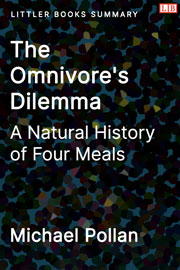Book Description
An eye-opening journey through the food chains, offering a deep understanding of the intricate relationships between humans and the food we eat.
If You Just Remember One Thing
The true cost of a cheap fast-food item is hidden, paid not at the register but through environme... More
Bullet Point Summary and Quotes
- Today's industrialized food chain is driven by profit and mass production and distribution. We no longer know what's truly in our food and we have infinite options, making it difficult to answer the question: What should we have for dinner?
- Before industrialization, food sources were localized and seasonal, sourced from small farms adhering to natural principles.
- We now face more food contamination, environmental damage, and health issues. These problems fueled the organic movement promoting sustainable and local options.
- Unlike other countries, America, a country of immigrants, lacks a strong food culture to guide healthy eating habits. Further confusion comes from fad diets, marketing ploys, and constantly shifting food guidelines.
- There are three principal modern food chains: industrial, organic, and hunter-gatherer.
- The industrial food chain, characterized by monoculture corn farms, is sustained by U.S. policies favoring big business, leading to corn overproduction and plummeting prices for farmers.
- Synthetic fertilizers and pesticides used in the industrial food chain result in environmental pollution and health issues.
- The automation of farming contributes to job losses and declining populations in Midwest towns.
- Corn's pervasive presence in processed foods, from chicken nuggets to sweetening agents like high-fructose corn syrup, has led to a surge in heart disease, obesity, and diabetes.
- 1/4 supermarket items contain a corn derivative.
- Cheap corn enables concentrated animal feeding operations (CAFOs) that are overcrowded, unsanitary, and ethically questionable. With corn serving as a primary feed for factory-farmed animals (even the carnivorous salmon), their natural diets are altered, necessitating the use of antibiotics to prevent them from being sick, which end up getting consumed by us.
- “Were the walls of our meat industry to become transparent, literally or even figuratively, we would not long continue to raise, kill, and eat animals the way we do.”
- “A growing body of research suggests that many of the health problems associated with eating beef are really problems with corn-fed beef.”
- The reliance on non-renewable fossil fuels across various stages of production (e.g., fertilization, processing, transportation) in the corn food chain exacerbates climate change concerns.
- A meal from McDonald's is an example of food from the industrial food chain. It is cheap, fast, prevalent, unhealthy, reliant on corn, and calorie excessive.
- “The 99 cent price of a fast-food hamburger simply doesn't take account of that meal's true cost -- to soil, oil, public health, the public purse, etc., costs which are never charged directly to the consumer but, indirectly and invisibly, to the taxpayer (in the form of subsidies), the health care system (in the form of food-borne illnesses and obesity), and the environment (in the form of pollution), not to mention the welfare of the workers in the feedlot and the slaughterhouse and the welfare of the animals themselves.”
- The industrial organic food chain, a blend of the industrial and organic systems, experienced a surge when major retailers like Whole Foods entered the organic market.
- Despite being “organic” (no antibiotics, pesticides, or synthetic fertilizers), they still use synthetic additives to prolong shelf life.
- Large-scale energy consumption for processing, refrigeration, and transportation still cause environmental concerns.
- The true organic chain works with nature, and its foundation is grass.
- In the organic chain, the plants, soil, and animals all benefit each other.
- Cattle graze, chickens eat insects and parasites from the manure, and the manure enriches the soil and plants.
- The pastured meat and eggs have higher nutritional value than industrial food, and they contain more healthy fats similar to wild game that humans evolved eating.
- It's actually cheaper to buy organic eggs if you're looking at the price per unit of omega-3 and vitamin E.
- Although generally pricier, the organic system reflects the true costs of production without compromising on flavor, health, or the environment, unlike subsidized industrial corn products.
- The author explored the hunter-gatherer chain through foraging, harvesting, and killing his own food.
- The ethics of killing animals are complicated, but the author believes that humans are biologically designed to eat meat but we must treat animals humanely, and factory farming's inhumane treatment of animals must be exposed and reformed.
- The hunter-gatherer experiment connected the author with food and nature, and didn't cost him much except for his time.
- “The single greatest lesson the garden teaches is that our relationship to the planet need not be zero-sum, and that as long as the sun still shines and people still can plan and plant, think and do, we can, if we bother to try, find ways to provide for ourselves without diminishing the world.”
The Omnivore's Dilemma: Resources
- Download this summary and 173+ other top nonfiction book summaries in one book (PDF, eBook, DOCX)
- Buy the book
